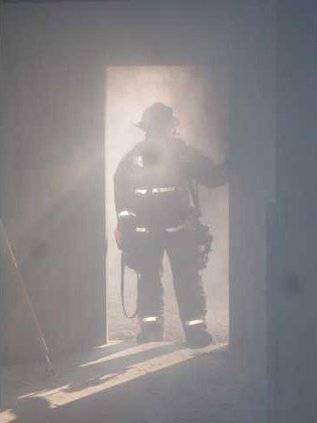Great Bend Fire Chief Mike Napolitano is a hands-on leader.
Napolitano sorted through equipment and verified that everything was in order for three days of fire training. The check list included thermal imaging cameras and portable fans.
Once the training started, he manned the frontline of the firefighters’ training Wednesday at the fire station west of town. The training for all of Great Bend’s firefighters will continue at 9 a.m. Thursday and Friday at fire station No. 2.
The firefighters face hazardous duty when practicing their profession.
Temperatures will exceed 1,000 degrees at the edge of the fire. There’s bulky protective gear to wear, noise, heat, water, smoke and limited visibility.
The new complex provides a perfect venue to practice firefighting techniques. Crews were given a variety of fires to fight.
“Having a burn building like this is invaluable. This is something we’ve never been able to train like this before,” said Mike Smith, firefighter 4. “This is as real as we can get without actually putting out a fire.
“We’ve practiced with fire behavior, but we had to make believe there is a fire,” Smith said. “Now, the fires are real. We can see what happens when we do something we see how the fire reacts. When we do something right, we see how the fire reacts.”
The fans feature improved technology. They used to suck smoke out of a building. Now, they are commonly used to blow smoke out of the building for improved visibility. A firefighter will quickly inspect the building to discover the best way to attack the fire and where it’s best to ventilate the fire.
A fan also quickly lowers the temperature inside a burning building.
“The fan pressurizes the building and pushes all the heat the smoke out the direction we want it to go,” Smith said. “It makes it a lot safer and allows us to work faster. The newest part is using the fan before firefighters go into a building.”
Smith said it was common that firefighters would face thick black smoke when entering a building. Now, there’s a better likelihood that visibility will be passable.
Fire Captain Mark Pohlman, a certified paramedic, said the fire training is valuable. Every piece of experience is important.
“You can’t simulate a lot of the conditions they see when fighting fires,” Pohlman said. “The heat, and how it behaves, is difficult to simulate. It’s always difficult dealing with the smoke and heat you face. when they see the thick smoke, they realize this is the real deal. It teaches everyone how to practice using their equipment.”
Firefighters will practice opening the best window for ventilation and understand how to quickly use their firefighting equipment.
The thermal imaging camera is a valuable device that uses infrared radiation that detects heat. The camera will tell the firefighters the temperature.
“If someone is in a building, you can spot them right away with the camera,” Pohlman said. “It quickly shows you the layout of the room.”
The department provides fire protection and rescue for Great Bend and four surrounding townships.
The department also provides EMS response and transport to the same area plus an additional 2 1/2 townships west of Great Bend. The total population served is 20,000 people, and the average response time is 3.5 minutes in the City and eight minutes in the county.
TRIAL BY FIRE
Firefighters helped by training





